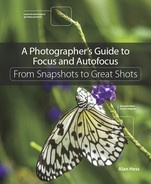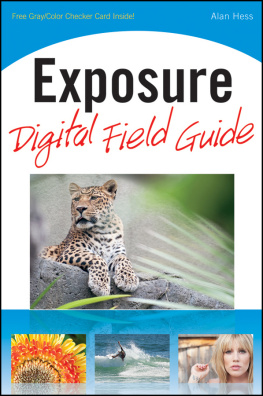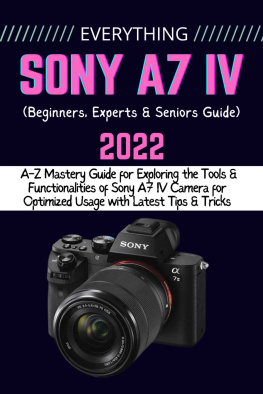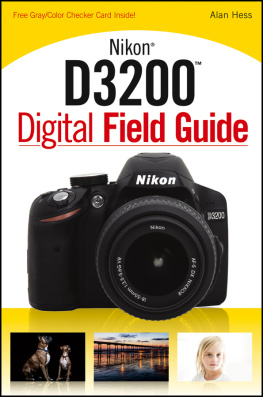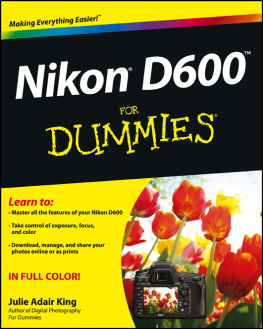To Nadra. Thank you for all the love and support.
Acknowledgments
I would like to thank all the people who took the time to help me with the book.
Scott Diussa, Mark Suban, Mark Kettenhofen, and Brien Aho for the great instruction and inspiration during the Nikon Video School.
Rick Sammon and Chuck Westfall for the Canon answers. Brian Smith for Sony help. Erika Thornes for answering questions about both the Sony and Canon camera systems.
A good camera store is one where you can go to get cameras, lenses, and gear. A great camera store is where you can go to get camera gear plus information and help, and just discuss the current state of photography. I live in a town that has a couple of great camera stores. I cant thank the whole staff over at Nelson Camera enough for the use of some loaner gear and support while I finished this book.
Thanks to Jerod Foster for the use of the some Canon lens images. You can check out his work at www.jerodfoster.com.
Thank you to the amazing team I get to work with at Peachpit for their hard work and quick turnaround during the writing process. I could not have done this without Valerie Witte, Linda Laflamme, Danielle Foster, Patricia Pane, and Valerie Perry. Thank you to Sara Jane Todd and Sheila Lease for all your hard work in getting this title into the hands of photographers.
Thank you to my friends and family for understanding the crazy writing schedule.
Finally, a huge thanks to my wife for her love, support, and patience. It is not easy to deal with me when Im writing a book, especially when I turn parts of the house into a makeshift studio for just one more photo. Thank you. I would not be able to do this without you.
Alan Hess
San Diego, CA
December 2015
Introduction
When I started to take photographs many years ago, there was no autofocus. I used to have to manually focus by turning the focusing ring on the lens until the image in the viewfinder was sharp. Only then could I start trying to compose the image in a pleasing way. Then along came autofocus, and the camera seemed to magically focus faster and better than I could. Taking photos became a lot easier. Autofocus has made it easier to take sharp, in-focus photos, but camera manufacturers keep trying to make the autofocus faster and better while giving photographers a lot more options. These options also make it a lot more complicated for photographers, especially for those just starting out with DSLRs.
Q: Why focus and autofocus?
A: With the advances in autofocus, photographers can get caught up in the technical settings and end up either missing the shot or getting a photo that is close, but not quite what they intend. Once you master the focus settings on your camera, however, you can concentrate on capturing your vision of the subject without continually worrying whether the image is sharp.
One of the things that prompted me to write A Photographers Guide to Focus and Autofocus was a photo I saw at a job. It captured a great moment, but the focus was off. The image bothered me. The greatness of the moment couldnt thoroughly shine, because the photo was just not as good as it could have been. The photographer failed to get the focus quite right. In writing this book, I wanted to share tips and information to help you master the focus settings, so you can capture your own great moments exactly the way you envision them.
Q: Who should read this book?
A: If you want a better basic understanding of the autofocus capabilities of your camera, this is the book for you. Whether youre just starting out on your photography journey or have hit a roadblock to capturing sharp images, this book will help.
Q: What does this book cover?
A: Covering a lot of basic information, this book is meant to be an overview, not a camera-specific guide. I use Nikon cameras and the majority of images for this book were taken with Nikon gear, but I know that many of you use Canon and Sony cameras. I have done my utmost to make sure that the terms used in this book and the techniques shown can be used on any of the camera systems.
Remember, too, that not all cameras are created equal. Professional cameras cost so much more than the entry-level models for a reason. I tried to make sure that I covered the capabilities of all the cameras, but please understand that your camera might not have the same number of focus points as the Canon 7D Mark II or the Nikon D750. That doesnt mean you cant get a lot of use from this book or that your camera wont take photos that are as good as those taken with a professional camera. So when youre using this book, it will help to have the camera manual or a camera-specific book like those in the Snapshots to Great Shots series handy to find the specific controls on your camera. That said, heres a preview of what youll find in A Photographers Guide to Focus and Autofocus:
gives you an overview of what to expect when using autofocus and when manual focus might be a better choice. It points out key techniques, useful features, and common scenarios that later chapters will revisit in more detail.

